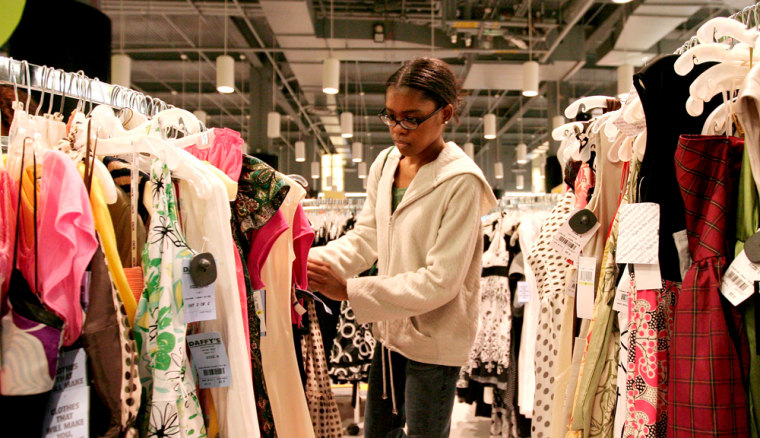With the bulk of some $100 billion in tax rebates now deposited in American consumers' bank accounts, the hoped-for boost in spending has proved disappointing for the nation’s retailers. As chain stores reported July sales figures on Thursday, there are signs cash-strapped households may cut back even further in the second half of the year.
When the economic stimulus package was enacted in February, analysts debated just how much of the money would translate into new spending. Now that most of the money has been distributed, it appears that much of it went to pay down credit card bills or beef up savings accounts.
“We expected that as the checks fade, so would sales,” said Goldman Sachs retail analyst Adrianne Shapira. “(Consumers are) filling up their SUVs, their home equity values are plummeting, and they're feeling a lot of pressures."
Those pressures may explain why the $100 billion worth of tax rebate checks didn’t give retailers a bigger lift in July. Some 28 percent of consumers surveyed in July by market researcher TNS Retail Forward said they used the money to pay off credit cards; 27 percent said they used it to pay for everyday expenses like groceries and gasoline, and 20 percent said they put the check into a savings account. Only 11 percent said they used the rebate for discretionary purchases like a new TV or a vacation.
Those spending patterns were reflected in Thursday’s reports from individual retailers. While sales were weak among most sectors, department stores and clothing chains were hit hardest. Overall, sales at the 14 major clothing chains tracked by Bernstein Research were down by an average of 3.1 percent compared to last July; sales at seven major department stores dropped 6.1 percent.
As consumers tightened their belts, the biggest winners were low-end discounters like Wal-Mart, Costco and Target; the seven big chains in that category saw sales pick up 4.6 percent over last July, according to Bernstein Research.
Now, with those rebate checks spent, retailers are warily looking toward sluggish sales through the rest of the year. Back-to-school shopping is already off to a slow start, especially for new clothes.
On Wednesday, MasterCard reported that sales of clothing and shoes fell in July, as consumers stretched to keep up with rising prices day-to-day staples like food and gasoline.
"We're continuing to see a divergence here in where the retail dollars are flowing," said Michael McNamara, an executive with SpendingPulse, MasterCard’s retail data service. "They really seem to be flowing into the nondiscretionary areas like drugstores, food and gasoline, and it's really coming at the expense of some of these retailers such as apparel and electronics and appliances."
That doesn’t bode well for the holiday shopping season, when many retailers look to make the bulk of their sales and profits for the year. With wages rising more slowly than inflation, consumers will have an even harder time making ends meet after their rebate checks have been spent.
“We think that when the stimulus checks end, which is this quarter, we’re going to hit an air pocket and disposable income will take a negative hit relative to what we saw in the second quarter,” said Brian Bethune, an economist with Global Insight.
There’s already talk in Washington about another round of stimulus checks to help offset the higher cost of energy. But with Congress in recess and the fall campaign heating up, it remains to be seen how quickly such a measure could be enacted.
There’s also considerable debate over whether the money would be better invested in infrastructure projects like rebuilding crumbling roads and bridges, which would help create jobs and could provide a more sustainable economic boost. The debate will also center on whether the benefits to the economy would offset the negative impact of borrowing more money the government doesn’t have.
“We have a $400 billion deficit, likely this year, more than double last year,” said Diane Swonk, chief economist at Mesirow Financial. “That's a lot of deficit going into the economy without a lot of payoff because it was driven by tax stimulus checks."
The recent pullback in oil prices may take some of the pressure off household budgets. But energy prices are still substantial higher than this time last year, and retailers have begun passing along their higher costs with selected price increases.
Faced with sluggish sales, store managers are also tightening their belts, cutting expenses where they can and keeping a tight rein on inventories. That will likely mean less surplus inventory — and fewer markdowns for consumers accustomed to waiting for seasonal sales promotions.
Unless energy prices fall further, the holiday shopping season will also likely be hurt by consumers' increased cost of heating their homes. Heating oil prices have roughly doubled since last year; natural gas price have also jumped. For consumers in cold weather states, those higher costs will begin showing up in their November and December heating bills, just as the holiday shopping season gets under way.
